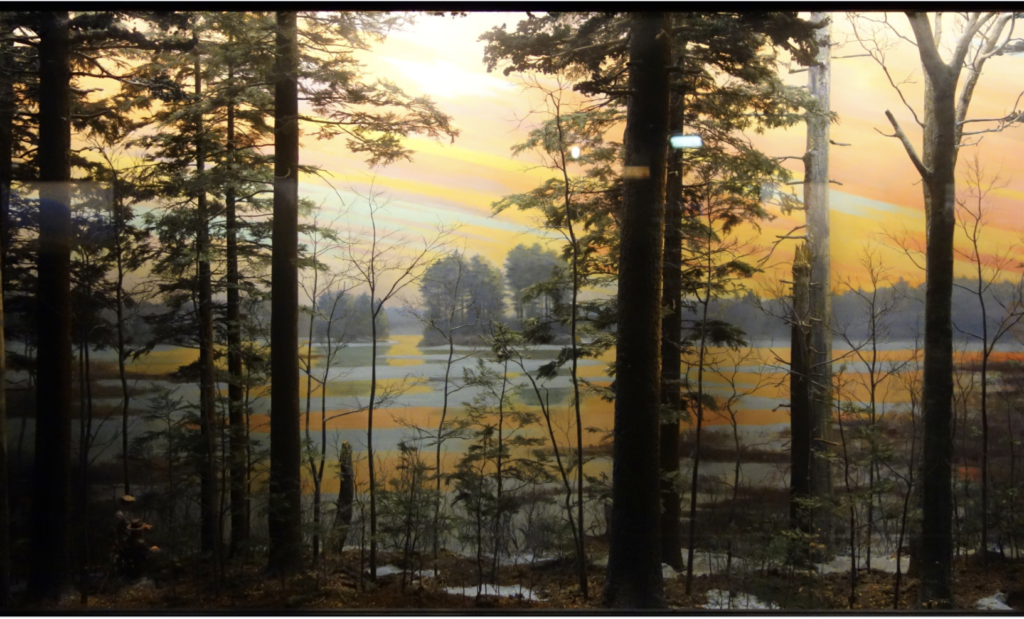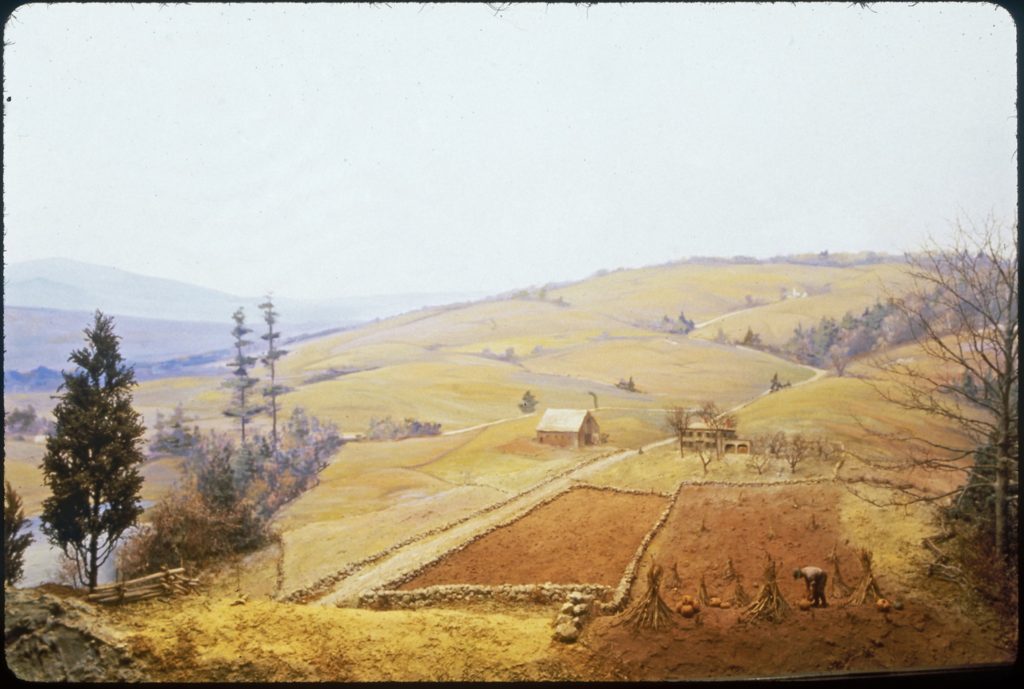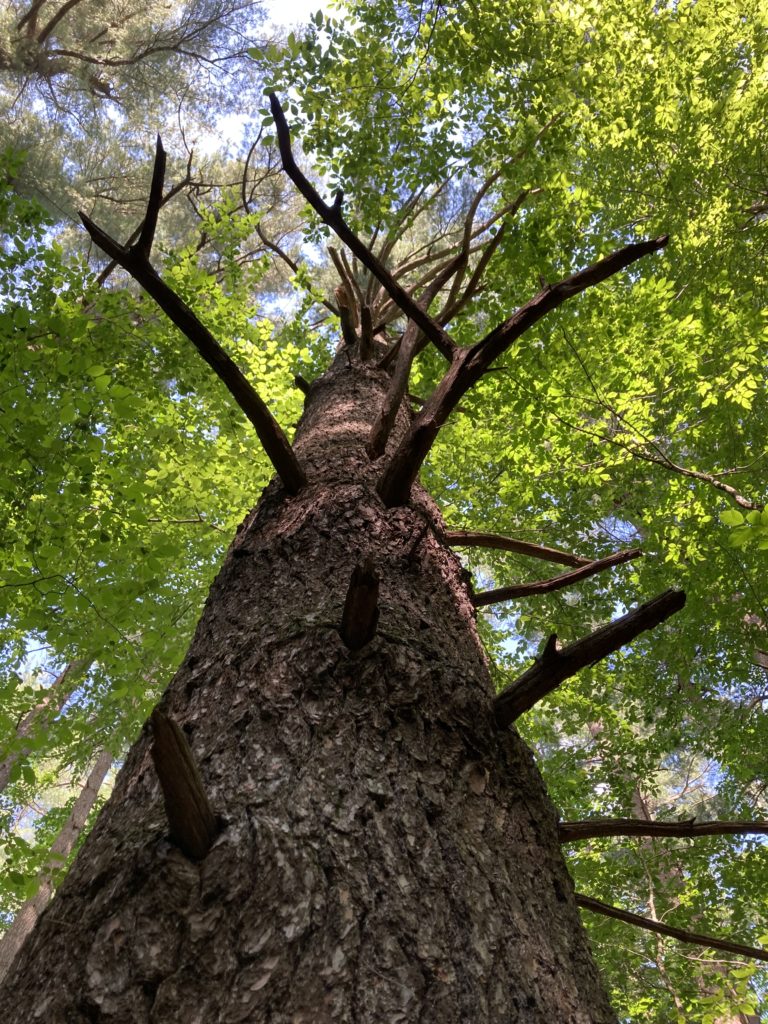Almanac: Giants

Artist's rendering of old white pine/hemlock forest at Harvard Pond in Harvard Forest. Photo: From a diorama at the Fisher Museum (Harvard Forest)
By the mid-19th -century most of rural New England resembled Ireland or northern Scotland—treeless hills and mountains whereupon grazed sheep and cattle with the lower elevations cleared for crops or orchards. In his detailed account of Northampton’s Mill River, environmental historian John Sinton writes of the Pioneer Valley settlers: “They cleared the forest of timber, and their diligence and persistence created a landscape in 1840 that would have been unrecognizable in 1780. Those who settled in old-growth forest, felling 200-year old oaks and chestnut and sugar maples, died surrounded by grasslands.”

Today, the forests have largely returned to New England, but they are forests in various stages of recovery/transition from a denuded 19th-century landscape. According to the Old-Growth Forest Network, only a fraction of 1% of eastern original forests remain standing. Few people, therefore, get to experience a forest of the scale and character of those existing prior to the arrival of European explorers and settlers in the 16th century.
Fortunately, a few pockets of ancient forest have survived, either as remnants of the primordial forest or as forests that have been left undisturbed for so long after some initial disruption (be it human-caused or natural) that they have recovered the species diversity and maturity of the original forests. The Old-Growth Forest Network has identified four such pockets in Massachusetts, the nearest of which is Bryant Woods at the William Cullen Bryant homestead in Cummington.
Bryant was born in 1794 and his family moved to what is now the much-enlarged “homestead” two years later. Whether the forests on the property were ever logged or otherwise disturbed is not clear—some parts certainly were, such as the area cleared for a lovely hay field that remains today. But a small area bordering a creek that inspired Bryant’s poem The Rivulet contains what are now some of the oldest and tallest trees in New England.
Last weekend a friend and I walked the roughly one-mile trail that loops through this majestic spot. We passed eastern hemlocks dated to more than 300 years old, several enormous white ash trees, and an astonishing black cherry measured at 102 feet tall, making it the second-tallest specimen in the state. Most impressive, however, is the roughly 10-acre northern area dominated by a stand of white pines that the Old-Growth Forest Network calls “among the tallest in the northeast.” Here are giants roughly 150–175 years old with enormous girths and tops soaring 130 to 150 feet above the forest floor. A 2006 survey of Bryant woods by the Native Tree Society found 29 white pines taller than 140 feet, with the tallest at 156 feet, which is a mere 2 feet shy of what was, in 1999, the tallest white pine in the state, located in the relatively nearby Mohawk Trail State Forest.

For fun, and as a great excuse to hug a tree, my friend and I tried to encircle one of the pines with outstretched arms. Fingers touching on one side, we came nowhere close to touching on the other side…we would need three people for that, meaning the circumference of that tree was probably about 12 feet. Granted, these are not sequoias, but they have the same gravitas as those venerable wonders and instill similar feelings of awe, respect, and wonder.
We encountered a series of numbered posts along the trail through the woods, but, frustratingly, no key to the numbers was available either at the various kiosks on the homestead property or on the homestead website run by the Trustees of Reservations. A map and key, however, is available on the Cummington Town website, which contains some interesting information about some of the trees and the characteristics of the woods.
I’m not a huge fan of Bryant’s poetry, some of which is displayed along the woodland trail, but I’m deeply grateful for his work to preserve natural areas and to fight for progressive causes. As the long-time editor of the New York Evening Post he endorsed organized labor, the rights of religious minorities and immigrants, and was one of the key eastern supporters of Abraham Lincoln. He was an ardent conservationist, involved in the creation of New York’s Central Park and, of course, he preserved, on his own property, a precious remnant of natural magnificence that can now be freely enjoyed by everyone in every season of the year.
Almanac is a regular Indy column of observations, musings, and occasional harangues related to the woods, waters, mountains, and skies of the Pioneer Valley. Please feel free to comment on posts and add your own experiences or observations.

To bike or to drive there? That is the question…. 😉
Thanks for writing this. My family hiked there one day and we stopped in an area, looking around, realizing the trees were really different, astonishingly tall with little undergrowth. Amazing experience and it also is sadly amazing that so little old growth is left in New England. But our newer growth forests take up a huge amount of carbon dioxoide every spring.